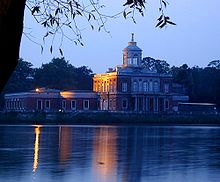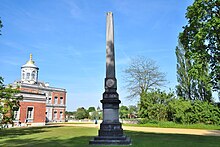New garden Potsdam
The new garden is a 102.5 hectare large park area on the north of Potsdam to the Holy See and the Jungfernsee borders. Friedrich Wilhelm II had a new garden laid out on this area from 1787, which was to stand out from the baroque Sanssouci Park .
The garden
Friedrich Wilhelm II acquired the property of a merchant on the Holy See during his time as Crown Prince, which was enlarged over the course of time through the purchase of adjacent orchards and vineyards. Work on the plant began a year after he took office. In keeping with the spirit of the times, the park was to reproduce a modern garden architecture and stand out from the outdated forms of the old Baroque ornamental and kitchen garden of Sanssouci Frederick the Great ; the naming as New Garden refers programmatically to it.
The Wörlitz complex was known to the king through trips to the small principality of Anhalt-Dessau . This earliest and largest landscape garden based on the English model on the European continent corresponded to its ideal in garden design. The Wörlitz gardener Johann August Eyserbeck was hired to implement this ideal .
In contrast to the extensive English landscape garden of the 19th century, the main elements of which were trees, meadows and water, the garden was structured according to the English model at the end of the 18th century by relatively enclosed garden areas, adorned with small garden architectures. Modeled on nature, the design emphasized the landscape character. The trees and plants should appear naturally uncut in free form.
Rural life was also rediscovered. Grazing cows were part of the image of the New Garden, whose milk was processed into butter and cheese in the dairy farm at the northernmost tip of the park . Garden houses that already existed and were included in the planning are still there today. They are called white, brown, red and green house after their facade color.
In 1816, Peter Joseph Lenné , who was still a gardener that year, came to Potsdam. He was given the task of redesigning the now overgrown garden. While retaining a few individual parts, he created an English landscape park with wide garden spaces, meadows and wide paths, but above all lines of sight to the Pfaueninsel , Glienicke , Babelsberg and Sacrow .
The buildings in the New Garden
With the creation of a new garden in Potsdam, Friedrich Wilhelm had a new palace built at the same time, between 1787 and 1793. According to plans by Carl von Gontard and Carl Gotthard Langhans , who was mainly responsible for the interior design, the Marble Palace was built , a work in the style of early classicism . With this building, the style that had long been widespread in the rest of Europe also found its way into Berlin-Brandenburg and ushered in the artistic change of epoch.
Friedrich Wilhelm II. Belonged to a lodge of the Freemasons and the more mystically oriented secret society of the Rosicrucians . Some of the buildings in the New Garden reflect the meaning of Freemasonry. The castle kitchen was built as a half-sunken temple, the ice cellar as a pyramid and the library in Gothic style . The architecture was not related to the actual purpose. Carl Gotthard Langhans and Andreas Ludwig Krüger created these functional buildings taken from another time.
The ice cellar , built in 1791/92 as a pyramid to the north in the line of sight of the Marble Palace, was used to keep the food fresh. In winter, ice was removed from the nearby Holy Lake and stored on the bottom floor of the basement, which was about 5 meters into the ground. The pyramid was extensively rebuilt in 1833 during the reign of Friedrich Wilhelm III by the master builder Albert Dietrich Schadow, whereby only individual stones with hieroglyphs from the original building were used.
The Gothic Library is at the southern end of the New Garden . The small, two-story pavilion housed the book collection of Friedrich Wilhelm II. In the lower area were the French works, in the upper area the German literature. In contrast to his predecessor Friedrich the Great , who preferred everything French, Friedrich Wilhelm II promoted German art. Pieces by Friedrich Schiller and Gotthold Ephraim Lessing were now allowed to be performed in Prussian theaters .
The orangery (1791/93) with the Egyptian portal on the east side is guarded by a sphinx . In the wall niches of the semicircular entrance area are two black-colored statues of Egyptian gods from the workshop of the sculptor Johann Gottfried Schadow . In the middle part of the elongated building is the wood-paneled Palm Hall. Public concerts were held here in which the musical king himself played the cello . The plant halls connect to the east and west.
Friedrich Wilhelm II had his refuge surrounded by a high wall along the west side. The main entrance to the park in the southwest is flanked by two gatehouses in the Dutch architectural style. Among other things, they contained stables and coach houses . Red brick houses, also in Dutch designs, are lined up along the dead straight avenue leading to the Marble Palace. This so-called Dutch establishment served as a residence for servants, but also as an attractive backdrop from the Holy Lake.
A crystal and shell grotto at the northern end of the New Garden was built in 1791/92 based on design drawings by Andreas Ludwig Krüger . The place to stay for warm summer days should look to the outside as created by nature. The three cabinets inside were decorated with mirrors, colored glass work and shells. The small bark kitchen built nearby in 1796 , demolished in 1958 due to dilapidation, was rebuilt in 2012. The round forest house is covered with reeds and covered with oak bark.
The castle kitchen (1788/90) in the form of an artificial ruin, located below the staircase of the Marble Palace and connected to it by an underground passage, only shows its front facing the lake. It seems like a half-sunken temple buried by earth.
The obelisk (1793/94) was built from blue-gray marble based on a design by Carl Gotthard Langhans. The four relief medallions were made by the Wohler brothers and Johann Gottfried Schadow and depict male heads of different ages. These are supposed to symbolize the four seasons.
The Herme of Themistocles was made of white marble from an ancient original . It shows the bust of the Greek general Themistocles . It was acquired by Friedrich Wilhelm Erdmannsdorff (* 1736; † 1800) for King Friedrich Wilhelm II (* 1744; † 1797) in Italy near Ostia (excavation site) in early August 1790. In 1791 this arrived in Potsdam and was given a new, unknown head in 1792. It was then erected on the land bridge between the Heiligen See and the Havel, diagonally opposite the Marble Palace, until 1830. After it was transferred to the museum in 1830, the Herme was given a replica of the “strategist's head”. From 1945, after the Second World War, the bust was lost. A new copy of the Herme and the “strategist's head” associated with it for a long time was set up again in 1993 where the original Herme stood between 1792 and 1830 in the New Garden.
Over a hundred years later, at the end of the reign of Kaiser Wilhelm II , the Hohenzollern's last palace was built in the New Garden. Between 1913 and 1917, Cecilienhof Palace was built for Crown Prince Wilhelm and his wife Cecilie in the north of the park. It served the family of the Crown Prince as a residential palace until the beginning of 1945.
Summary overview of the buildings
Under King Friedrich Wilhelm II , the following were created in the New Garden between 1787–1796:
- Marble palace
- Castle kitchen in the form of a temple ruin
- Orangery
- Gothic library
- pyramid
- Dairy farm
- Shell grotto
- "Holländisches Etablissement" (Dutch-style houses)
- Bark kitchen, built in 1796, demolished in 1958, reconstruction in 2012
- Hermitage
Built under Kaiser Wilhelm II from 1914 to 1917 for Crown Prince Wilhelm :
literature
- Gert Streidt, Klaus Frahm: Potsdam. The castles and gardens of the Hohenzollern . Könemann Verlagsgesellschaft mbH. Cologne 1996, ISBN 3-89508-238-4 .
- Arachne, central object database of the German Archaeological Institute (DAI) and the Archaeological Institute of the University of Cologne.
Web links
- the colorful houses in the New Garden
- Prussian Palaces and Gardens Foundation Berlin-Brandenburg
- Arachne, central object database of the German Archaeological Institute (DAI)
Individual evidence
- ↑ New garden. Moving away from the Baroque Park under King Friedrich Wilhelm II. Foundation Prussian Palaces and Gardens Berlin-Brandenburg , accessed on May 9, 2017 .
- ↑ see: Martin Gussone, The "Egyptization" of the pyramid in the New Garden in Potsdam, in: Koldewey-Gesellschaft (Ed.), Report on the 44th Conference for Excavation Science and Building Research from May 24th to 28th, 2006 in Wrocław / Breslau (Habelt-Verlag: Bonn 2008) 228-237.
- ↑ Günter Schenke, “Bark - rarer than gold leaf: Bark kitchen and Hermitage rebuilt thanks to sponsorship” , in: Potsdamer Latest News (Tagesspiegel), September 26, 2012; Retrieved August 26, 2016.
Coordinates: 52 ° 24 ′ 55.5 " N , 13 ° 4 ′ 9.7" E











